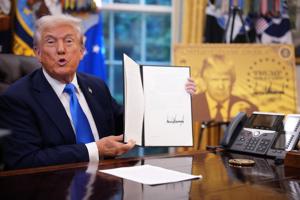Top Stories
Canada Must Act Fast Amid Trump’s $100K Visa Fee for Workers

UPDATE: U.S. President Donald Trump has just announced a staggering $100,000 admission fee for highly skilled foreign workers, creating an urgent opportunity for Canada to attract talent. This new policy, effective from September 21, 2023, could significantly shift the landscape of skilled labor as Canada positions itself as a viable alternative for those seeking employment.
This development has been met with enthusiasm from Canadian officials. Prime Minister Mark Carney declared this an optimal moment for Canada to attract the global talent that might have otherwise flocked to the U.S. “Not as many of those people are going to get the visas to the United States,” Carney stated. “These people have a lot of skills… we are going to have a clear offering on that.”
However, the situation is not straightforward. Experts warn that desperate U.S. employers may turn to Canada as a resource to fill skill gaps, taking advantage of the Canada-United States-Mexico Agreement (CUSMA). Rick Lamanna, an immigration lawyer, emphasized the ease with which American companies can hire skilled workers from Canada to avoid the hefty fee. “It’s much easier to hire these folks from Canada,” he noted.
Current data reveals that in the 2024 fiscal year, the U.S. issued 27,871 new TN visas, which allow Canadian and Mexican citizens to work in the U.S. This figure underscores the potential for increased poaching of Canadian talent, especially since U.S. corporate America is reportedly “nervous” about the implications of Trump’s new fee.
With a limited pool of 85,000 H-1B visas available annually, companies are forced to reconsider their strategies. The new fee adds a layer of financial strain, leading many employers to rethink how they approach hiring foreign talent. Matt Downer, a partner at EY Law LLP, highlighted that the impending weighted lottery system for H-1B visas will favor more experienced candidates, further squeezing younger skilled workers out of opportunities.
The implications for Canada are profound. As the youth unemployment rate in Canada hovers around 14.5%, there’s an urgent need to ensure that Canadian graduates are not left competing against a wave of U.S.-shut-out applicants. Barbara Jo Caruso, a Toronto corporate immigration lawyer, cautioned that Canada’s current immigration policies must not overlook those foreign workers already in the country, especially international students who are struggling to obtain permanent residency.
“If we cherry-picked foreign workers that were being squeezed out by the U.S. and we overlooked those foreign workers that are in Canada, what message does that send the world?”
This sentiment resonates amid public concerns regarding immigration and job availability. Many Canadians fear that focusing solely on attracting talent displaced by U.S. policies could reflect poorly on Canada’s commitment to existing immigrants.
To secure this opportunity, Canada needs a robust strategy tailored to the shifting dynamics of global labor markets. Lamanna emphasized that a clear pathway to permanent residency for skilled workers is essential. Without this, many could easily pivot back to the U.S. once they qualify for L-1 visas, which allow intracompany transfers.
In 2023, Canada attempted to address the talent shortage with a program granting three-year work permits to U.S.-based H-1B visa holders affected by layoffs. Over 10,000 applications were filled within just two days, showcasing the demand for such initiatives. However, concerns lingered about the effectiveness of this program, as it did not mandate employment with Canadian companies.
Gabriela Ramo, a partner at EY Law LLP, asserted that Canada must prioritize attracting diverse talent from the U.S. H-1B pool and ensure that immigration programs align with market needs. “You need to tie the bringing in of the people to how employers are going to use that talent,” she urged.
As the situation develops, the focus remains on how Canada can quickly adapt to an influx of talent while safeguarding its own skilled workers. The decisions made in the coming weeks will be crucial in determining whether Canada can capitalize on this unique opportunity or risk losing its talent to the U.S.
-

 Politics4 weeks ago
Politics4 weeks agoSecwepemc First Nation Seeks Aboriginal Title Over Kamloops Area
-

 World5 months ago
World5 months agoScientists Unearth Ancient Antarctic Ice to Unlock Climate Secrets
-

 Entertainment5 months ago
Entertainment5 months agoTrump and McCormick to Announce $70 Billion Energy Investments
-

 Science5 months ago
Science5 months agoFour Astronauts Return to Earth After International Space Station Mission
-

 Lifestyle5 months ago
Lifestyle5 months agoTransLink Launches Food Truck Program to Boost Revenue in Vancouver
-

 Technology3 months ago
Technology3 months agoApple Notes Enhances Functionality with Markdown Support in macOS 26
-

 Lifestyle3 months ago
Lifestyle3 months agoManitoba’s Burger Champion Shines Again Amid Dining Innovations
-

 Top Stories2 months ago
Top Stories2 months agoUrgent Update: Fatal Crash on Highway 99 Claims Life of Pitt Meadows Man
-

 Politics4 months ago
Politics4 months agoUkrainian Tennis Star Elina Svitolina Faces Death Threats Online
-

 Sports5 months ago
Sports5 months agoSearch Underway for Missing Hunter Amid Hokkaido Bear Emergency
-

 Politics5 months ago
Politics5 months agoCarney Engages First Nations Leaders at Development Law Summit
-

 Technology5 months ago
Technology5 months agoFrosthaven Launches Early Access on July 31, 2025



















